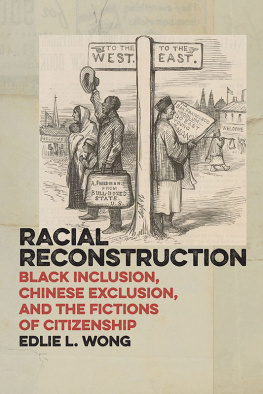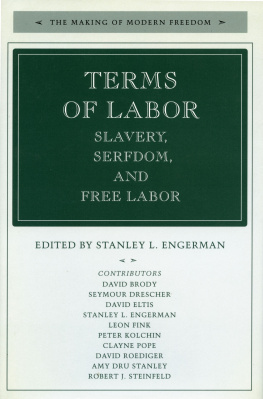ISBN: 978-0-8131-5414-5
Library of Congress Catalog Card Number: 77-76334
Copyright 1978 by The University Press of Kentucky
A statewide cooperative scholarly publishing agency serving Berea College, Centre College of Kentucky, Eastern Kentucky University, The Filson Club, Georgetown College, Kentucky Historical Society, Kentucky State University, Morehead State University, Murray State University, Northern Kentucky University, Transylvania University, University of Kentucky, University of Louisville, and Western Kentucky University.
Editorial and Sales Offices: Lexington, Kentucky 40506
To John P. Roche
Foreword
The history of American blacks between the end of slavery and the beginning of the modern civil rights movement has been sadly neglected. In contrast, the publication of Kenneth Stampps The Peculiar Institution in 1956 sparked a renaissance of scholarship in the sociology, psychology, history, and economics of slavery. The new research, challenging insights, and novel theories of Stanley Elkins, Herbert Gutman, Eugene Genovese, Robert Fogel, Stanley Engerman, and others has ignited scholarly and popular controversy. But if one result of the renewed interest in slavery has been an enriched understanding of an extraordinarily important period in the evolution of American race relations, considerable confusion is a by-product. The problem is not that the theories of this or that scholar have a pernicious effect on public attitudes or policy. Rather it is that this renewed interest reinforces the tendency to reduce the history of American blacks to the history of slavery. It is widely assumed, perhaps unconsciously, that the proper understanding of slavery holds the key to the recovery of our cities, to the solution of the welfare crisis, and even to the ending of racial discrimination and inequality. Although slavery is clearly the basis for all future developments of relations between the races, it does not and cannot explain everything. A fuller and more accurate history of slavery is essential, but our understanding will be restricted and incomplete until and unless we have an equal grasp of the history of the American black following emancipation.
Daniel Novaks The Wheel of Servitude: Black Forced Labor after Slavery is, thus, of more than intrinsic importance and interest. It is an indication that a new generation of scholars may be beginning to recognize the importance of this neglected period in American history. Although Novaks work is primarily a legal study, it is filled with important insights into the new economic and social system that replaced slavery. It provides much-needed perspectives on the postslavery South that will be of interest not only to professional historians, but also to everyone who is concerned with understanding the historical and social development of racism and race relations in the United States.
While the failure of Reconstruction, radical or otherwise, to establish a strong and secure basis for black freedom and equality by economically transforming southern society is well known, much less attention has been given to trying to understand what replaced slavery. The usual concentration upon the politics of the Radical legislatures has, if anything, directed attention away from the more critical questions of economic relationships that replaced slavery. Daniel Novak builds a convincing case that the new system had much in common with slavery: the old fugitive slave laws were reborn, and the convict-labor system quoted prices for classes of prisoners which were taken directly from the terminology of slavery. His detailed examination of the laws governing labor relations in the postwar South yields a stark and depressing picture of a new social and economic system that continued the oppression and degradation of black workers. As legally defined, the new system closely paralleled serfdom. In fact, Novak observes, compared to the medieval serf the freed Negro had considerably less legal protection, while the control of his movements was at least as great.
The accepted wisdom that the entrenchment of Jim Crow was primarily the result of the withdrawal of federal troops from the South following the compromise of 1877 is persuasively challenged by Novak. He points out that not only did the federal government fail to reconstruct the South, but that it can accurately be described as a partner in the creation of the new system. It was the Freedmens Bureau, not southern bourbons or the Ku Klux Klan, which initiated and enforced the regulations that became models for the Black Codes, the legal foundation and reflection of the new system of forced labor. Although the bureau and the army did try, within limits, to protect the rights of the freedman, they basically supported the emerging system of control.
Even more surprisingly, not a single radical southern legislature became involved in the labor field in a way that might have, however briefly, destroyed the peonage system set up by the Black Codes and the Freedmens Bureau. Radicalism was restricted to issues like suffrage, segregation, and education, while legislation on labor remained essentially conservative. Thus, during the period when radicalism supposedly ran rampant over the defeated South, something far different was happening. As Novak writes, the newly freed agricultural worker was, by consensus, placed in a position of peonage.
The Wheel of Servitude suggests that economics, especially the forced labor system, must be placed at the center of the historians vision if we are to understand southern history. In Novaks hands this approach yields valuable insights into the nature of the Populist movement and the reasons for its failure. The Populist movement virtually ignored the needs of agrarians caught in the trap of sharecropping and wage labor, the positions occupied by the overwhelming majority of Negro farmers. This was not accidental, according to Novak, for the Populist movement was based upon property-owning farmers. Thus, it is not surprising that Populism did not fundamentally challenge the southern system.
The great value of Daniel Novaks The Wheel of Servitude is, however, the clarity he brings to explaining the legal mechanisms that reenslaved the newly freed blacks and to discussing how the laws reflected the dependence of the southern economy upon a system of forced labor. Changes in the lien laws, for instance, are convincingly explained here as a response to the growth of sharecropping and tenantry as alternatives to wage labor.
The Wheel of Servitude is of more than historical interest. In one sense, it is a case study of the centrality of economics to the progress of social justice. More important, as Novak reminds us, peonage is a current issue. Cases of peonage have been reported in North Carolina and Florida during the summer of 1977 and there is no doubt that even today this form of near slavery is a great deal more extensive than most Americans would like to believe.
Both scholars and social activists will be richly rewarded by reading this illuminating study of a critical and little-understood period in American history, a study that traces the connections between the southern legal structures and the new system of labor control that emerged in the aftermath of the Civil War.







